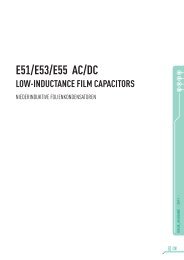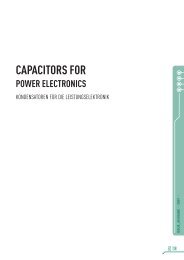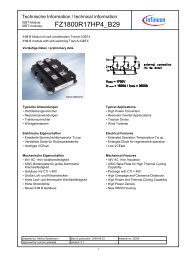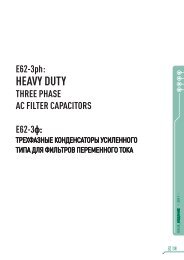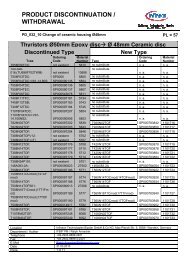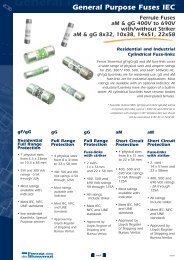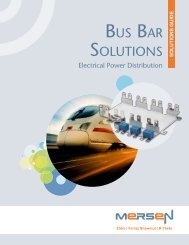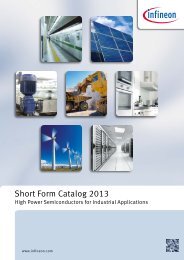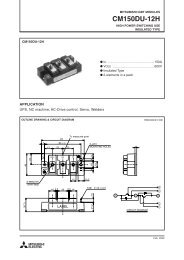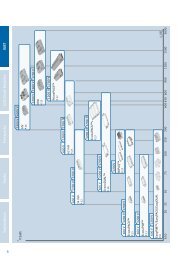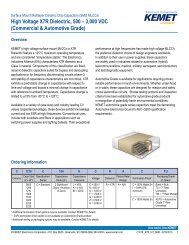Quality Policy
Quality Policy
Quality Policy
- No tags were found...
Create successful ePaper yourself
Turn your PDF publications into a flip-book with our unique Google optimized e-Paper software.
ENVIRONMENT & PRODUCT SAFETYPRODUCT SAFETYTHESE NOTES SHOULD BE READ INCONJUNCTION WITH THE PRODUCTDATA SHEET. FAILURE TO OBSERVETHE RATINGS AND THE INFORMATIONON THIS SHEET MAY RESULT IN ASAFETY HAZARD.WARNINGWhen potentially lethal voltages e.g. 30Va.c. (r.m.s) or 60V d.c. are applied to theterminals of this product, the use of ahazard warning label is recommended.In the case of motor start capacitorsthey meet the requirements of BritishStandard Specifications BS.5267:1976 and reference should be made toAppendix C -Guide for installation andoperation.1. ELECTROLYTEAluminium electrolytic capacitors containliquids (electrolytes) which can behazardous. The electrolytes are conductingsolutions of organic and/or boric acid,neutralised with amines or ammonia, ina variety of solvents. The major solventsare butyrolactone and ethylene glycol. Cosolventse.g. N-methyl pyrolidone may bepresent. Inorganic or organo-phosphatesare present in low concentration. Thephysical, chemical and toxicologicalproperties of the electrolytes are largelydetermined by the solvents, as summarisedbelow:Physical Properties1. Low viscosity - typically 5 - 50 cp at25°C2. Combustible - Flash points 95 - 120°C3. Low vapour pressure -< 20mm Hg at25°CChemical properties1. Non-corrosive.2. Can be aggressive to many plastics,lacquers and resins.3. Totally soluble in hot water.ToxicologyThe electrolytes are moderately toxic, withLD50 values in the range 1.5 -2g/Kg.Skin exposure can cause drying and defatting.Severe irritation may be caused tothe mucous membranes, particularly theeyes, where conjunctivitis may result.Safety PrecautionsIn the event of electrolyte escape, wash theaffected area with hot water. Use rubbergloves to avoid skin contact. Any contactwith the eyes should be liberally irrigatedwith water, and medical advice sought.Note - the electrolyte systems do notcontain materials currently listed ascarcinogenic, mutagenic or teratogenic,e . g . p o l y c h l o r i n a t e d b i p h e n y l s(PCB’s), dimethylformamide (DMF) ordimethylacetamide (DMA).2. INTRINSIC PROPERTIESOperatingD.C. capacitors are polar devices, and willoperate safely only if correctly connected.Reversing the connections will result in highleakage currents which could subsequentlycause short circuit failure, rupture of thesafety vent and possibly explosion andfire.Correctly polarised operation may result inthe above failure modes if:• the surge voltage is exceeded.• the ambient temperature is too high.• excessive ripple currents are applied.A.C. types are non-polar. Catastrophicfailure may be caused by:• Abnormal duty cycles.• Voltage in excess of rated value.• Ambient temperature too high.Non OperatingAluminium electrolytic capacitors containliquids which can leak out (see materialcontent).Damage to the encapsulation may causeleakage of the electrolyte. Excessivetorque or soldering heat may affect theperformance of the capacitor or damagethe sealing.Electric shock may result if capacitors arenot discharged.3. FLAMMABILITYMost plastics and elastomers arecombustible i.e. will ignite if an ignitionsource is applied under suitable conditionsof temperature and oxygen level.For most published data, the UL94Horizontal or Vertical Burning Systemhas been applied. Although useful forcomparative values, this test is notpracticable, as the ignition characteristicsare strongly influenced by the materialdimensions, and other materials withwhich they may be in intimate contact.Evox Rifa / BHC has completed a seriesof flammability tests based on a NeedleFlame Test, as specified in IEC 60695-2-2. Details of the tests undertaken on boththe external components and internalwind elements, can be found in a fulltechnical article, TD005, “FlammabilityCharacteristics” contained within BHC“Aluminium Electrolytic Capacitors –Application Notes”.4. DISPOSALAluminium Electrolytic Capacitors areconsignable waste under the Special WasteRegulations 1996 (Statutory Instrument1996 No 972), which complies with theEC Hazardous Waste Directive – Directive91/689/EEC. The electrolyte shouldtherefore be treated as a hazardous wasteand advice should be sought from thelocal office of the Environmental Agencyregarding it’s disposal. In the UnitedKingdom there are two possible methodsof disposal; high temperature incinerationand landfill, from which the user shouldseek the best practicable environmentaloption.Due to the construction of an aluminiumelectrolytic capacitor, high temperatureincineration may cause the componentto explode due to build-up of internalpressure. In addition, incineration may alsocause the emission of noxious fumes. If itis decided that this is the best practicableoption then it must be carried out undercontrolled conditions and at a minimumtemperature of 1200°C. It should also beconfirmed that the incinerator is authorisedunder parts A or B of the EnvironmentalProtection Act.The alternative is to dispose of them in anengineered lined landfill site that is licensedto take materials identified on the safetysheet. It should be stressed that thesecapacitors are not to be disposed of in aland fill site set aside for domestic waste.Evox Rifa / BHC strongly recommend that ifthere are any doubts regarding the disposalof aluminium electrolytic capacitor, thatadvice be sought from the local regulatingauthority.In addition, Evox Rifa /BHC would like torequest that users of aluminium electrolyticcapacitors respect the needs of theenvironment and wherever possible recoveras much of the materials as possible, i.e.aluminium.5. UNSAFE USEMost failures are of a passive nature anddo not represent a safety hazard. A hazardmay, however, arise if this failure causes adangerous malfunction of the equipment inwhich the capacitor is employed. Circuitsshould be designed to fail safe under thenormal modes of failure.The usual failure mode is an increasein leakage current or short circuit.Other possible modes are decrease ofcapacitance, increase in dissipation factor(and impedance) or an open circuit.Capacitors should be used in a wellventilatedenclosure or cabinet.7. MOUNTINGCare should be taken when mounting byclamp, that any safety vent in the can isnot covered.8. FUMIGATIONIn many countries throughout the worldit is now common practice to fumigateshipments of products in order to controlinsect infestation, particularly whenwooden packaging is used. Currentlymethyl bromide is widely used as afumigant and this can penetrate cardboardpacking and polymer bags and thereforecome into direct contact with equipmentor components contained within.KEMET Electrolytic Capacitors19



